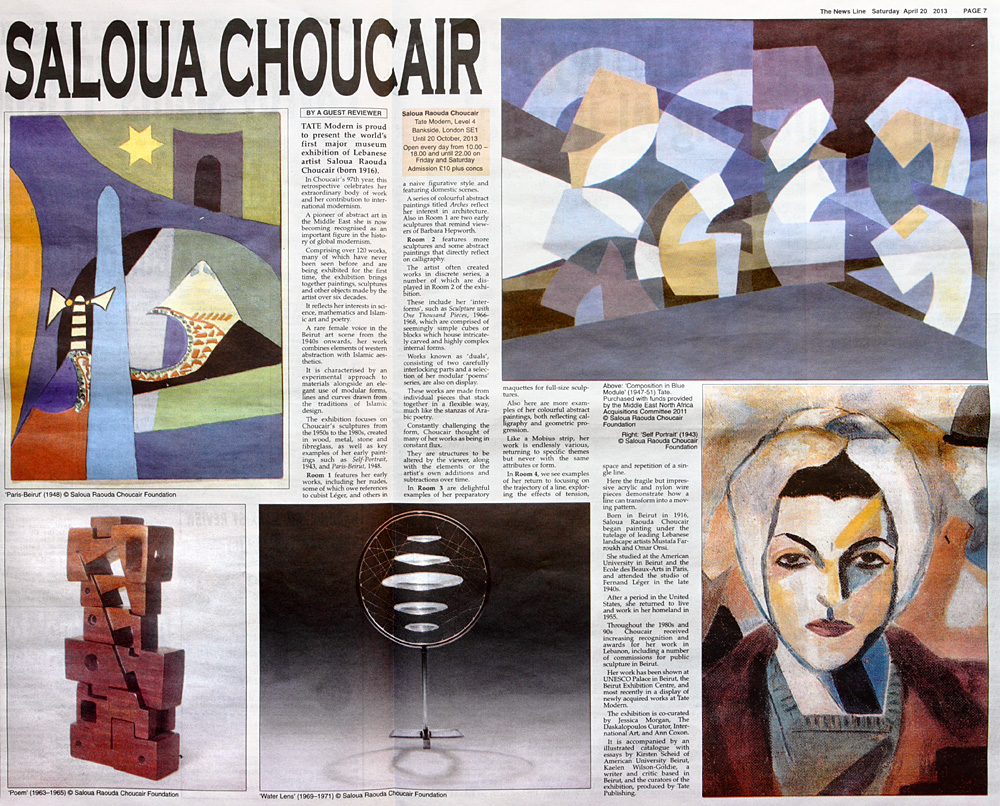|
The News Line Saturday April 20
2013 PAGE 7
SALOUA CHOUCAIR
BY
A GUEST REVIEWER
Saloua Raouda Choucair
Tate Modern, Level 4 Bankside,
London SE1
Until 20 October, 2013
Open every day from 10.00- 18.00 and until 22.00 on Friday and Saturday
Admission £10 plus concs
TATE Modern is proud to present the world's first major museum exhibition
of Lebanese artist Saloua Raouda Choucair (born 1916).
In Choucair 's 97th year, this retrospective celebrates her extraordinary
body of work and her contribution to international modernism.
A pioneer of abstract art in the Middle East she is now becoming
recognised as an important figure in the history of global modernism.
Comprising over 120 works, many of which have never been seen before and
are being exhibited for the first time, the exhibition brings together
paintings, sculptures and other objects made by the artist over six
decades.
It reflects her interests in science, mathematics and Islamic art and
poetry.
A rare female voice in the Beirut art scene from the 1940s onwards, her
work combines elements of western abstraction with Islamic aesthetics.
It is characterised by an experimental approach to materials alongside an
elegant use of modular forms, lines and curves drawn from the traditions
of Islamic design.
The exhibition focuses on Choucair's sculptures from the 1950s to the
1980s, created in wood, metal, stone and fibreglass, as well as key
examples of her early paintings such as Self-Portrait, 1943, and
Paris-Beirut, 1948.
Room 1 features her early works, including her nudes, some of which owe
references to cubist Leger, and others in a naive figurative style and
featuring domestic scenes.
A series of colourful abstract paintings titled Arches reflect her
interest in architecture. Also in Room 1 are two early sculptures that
remind viewers of Barbara Hepworth.
Room 2 features more sculptures and some abstract paintings that directly
reflect on calligraphy.
The artist often created works in discrete series, a number of which are
displayed in Room 2 of the exhibition.
These include her 'interforms', such as Sculpture with One Thousand
Pieces, 1966- 1968, which are comprised of seemingly simple cubes or
blocks which house intricately carved and highly complex internal forms.
Works known as 'duals', consisting of two carefully interlocking parts and
a selection of her modular 'poems' series, are also on display.
These works are made from individual pieces that stack together in a
flexible way, much like the stanzas of Arabic poetry.
Constantly challenging the form, Choucair thought of many of her works as
being in constant flux.
They are structures to be altered by the viewer, along with the elements
or the artist's own additions and subtractions over time.
In Room 3 are delightful examples of her preparatory maquettes for
full-size sculptures.
Also here are more examples of her colourful abstract paintings, both
reflecting calligraphy and geometric progression.
Like a Mobius strip, her work is endlessly various, returning to specific
themes but never with the same attributes or form.
In Room 4, we see examples of her return to focusing on the trajectory of
a line, exploring the effects of tension, space and repetition of a single
line.
Here the fragile but impressive acrylic and nylon wire pieces demonstrate
how a line can transform into a moving pattern.
Born in Beirut in 1916, Saloua Raouda Choucair began painting under the
tutelage of leading Lebanese landscape artists Mustafa Farroukh and Omar
Onsi.
She studied at the American University in Beirut and the Ecole des
Beaux-Arts in Paris, and attended the studio of Fernand Leger in the late
1940s.
After a period in the United States, she returned to live and work in her
homeland in 1955.
Throughout the 1980s and 90s Choucair received increasing recognition and
awards for her work in Lebanon, including a number of commissions for
public sculpture in Beirut.
Her work has been shown at UNESCO Palace in Beirut, the Beirut Exhibition
Centre, and most recently in a display of newly acquired works at Tate
Modern.
The exhibition is co-curated by Jessica Morgan, The Daskalopoulos Curator,
International Art, and Ann Coxon.
It is accompanied by an illustrated catalogue with essays by Kirsten
Scheid of American University Beirut, Kaelen Wilson-Goldie, a writer and
critic based in Beirut, and the curators of the exhibition, produced by
Tate Publishing.
http://www.wrp.org.uk
|

